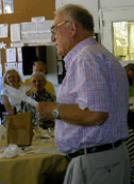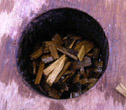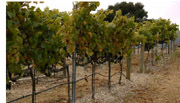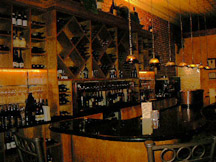
| August 27, 2005 Part of the winemaker’s craft is knowing when to make adjustments. For those with 25 – 30 years of experience, their skill allows them to make fine adjustments, as Picasso might to a painting. But for the novice, adjusting nature’s work is as dangerous to the wine as a 5-year old playing with matches. Something didn’t seem right with our 2004 Syrah, which started out with so much promise and high expectation. I’m surprised because the bottle I brought back to the East Coast a few weeks ago – after being decantered for a full-day and enjoyed with roast beef (after a couple of glasses of champagne with hors d’oeuvres) tasted so smooth and was enjoyable. However, when tasting this week, the wine starts out full, strong, but finishes weak with a “tart” aftertaste. This tart aftertaste was a mystery. I took a sample to the local winemakers' association monthly meeting last week, and asked a few experienced wine makers to taste it. One fellow took a sip and spit it out: “Too much acid!” Asked another, “Did it go through malolactic fermentation?” How was I supposed to know (at least now I know what malolcatic fermentation is … sort of). When I returned home that evening I tested a sample with an acid testing kit, which didn’t indicate acidity was too high. I reviewed the notes Ryan gave me – who had done a chemical test back in April – which indicated the wine was at a proper acidity, pH and Sulfur Dioxide. We are getting near the time when I was thinking about bottling, but something didn’t feel right. I resolved to find help. I sought out The Master. Lum Eisenman spends Wednesday’s at Belle Marie Winery in Escondido and this morning he was not particularly busy (the crush season has not yet started for them). I called the day before. Mary – for whom the winery is named – answered the phone, and was kind enough to invite me to stop by. (Another example of the camaraderie that exists in the wine industry -- at least in Southern California. And why not, a good drink makes good companions. Or, misery -- and the hard work of making wine -- loves company.) I walked into the winery shortly after 9:30 am, and behind a stack of wine barrels reaching up to the ceiling was Lum with a chart in one hand and a glass of red in the other. I asked him if he would test it, and he agreed. I had siphoned a sample from our barrel that morning. He poured some into his glass, sniffed, and passed the wine to an assistant cellar master to smell. There was something about that smell that wasn’t right to him. “Can you notice it?” “I just brushed my teeth,” I replied. I told him I took that sample directly from the barrel that morning, and that he might be noticing a slight essence from the little blue bucket I emptied it in before filling the plastic water bottle. He pulled a chemical from the cupboard, and measured a couple of drops into the glass, swirled it, and put it to his nose. “Isn’t that better?” he asked, passing the glass around. I’m reminded of junior high science class as Lum lures the correct amount of wine into a measuring device with his mouth (the scientific term for the device escapes me at the moment) and empties it into a beaker. He then dilutes the wine, adds a chemical, a drop at a time, causing the wine to turn darker, until it resembles the ink of an octopus. He’s doing a measurement for acidity, which I did in our bathroom sink just the night before. He does it with precision. It measures .64 (in the ballpark). Next, he measures the pH. The first reading is off the scale, so he recalibrates the equipment. The pH comes in at 3.53 (in the ballpark). There’s nothing wrong with the wine, and I breath a sigh of relief. He takes another taste. “This is clear.” A compliment. “It’s just young, and needs to age more,” he advises. “Don’t put it in the bottle too soon. Try adding some oak chips.” The oak from our French oak barrel has not come through. I wonder if last year when we cleaned out the barrel, we may have washed the flavor away. He draws for me three sizes of oak chips. “The big ones will take about 3 months,” to impart their flavor. The medium sized ones less time. “These will take about a week,” he says of the small chips. The chips I’ve ordered haven’t arrived, so I’m not sure what size I’ll be getting. “Taste it after adding the chips, then decide when to put it into the bottle.” “There are no pathogens in wine,” he says. I tell him the story related to me by my wife, about the guy who drank fermenting grape juice and didn’t live to write about it. “But if you’re in the vineyard, and pass around the glass and someone has a cold, everyone’s going to get it,” he warns. “You’re just drinking grape juice.” The gospel according to Lum states that you can pass around a wine glass and everyone may drink from it without fear of catching a cold. I heard something similar from Father Cory Randall, the retired rector of St. Peter’s Del Mar Church, who said that you’re likely to get germs from people dunking the host (the bread) during Eucharist rather than taking a sip directly from the cup. Before the Master, I feel lower than Luke Skywalker before meeting Yoda the first time. I am witnessing a living legend at work. There are no photographs. No autographs. No declaration of how I aspire to follow in his footsteps. It’s a moment in time, and I feel it will be repeated in the years ahead. “How much do I owe you?” reaching into my pocket. He’s a professional providing a service, and I am glad to pay for the advice. “How about a bottle of wine?” he asks. How about a case, I think. “Yes sir,” gladly. Another example of generosity of the fraternal order of winemakers. “Do you need the wine for topping?” he asks of the leftover. “I have plenty for that, but will take it and put it to good use.” I decide to give it to Jose at the Projector Doctor, my next stop. Oh yes, my daytime job, and it’s time to get going. I wash my tasting glass, and Lum straightens up the lab, preparing to go back into the cellar. “What’s on the agenda today, just routine maintenance?” I’m making small talk. A genius stands before me (I’m not prepared for the honor). I just want to stay and soak up knowledge. “One of the things I’ve learned from your classes and tasting your wine is that I love Nebbiolo. I’d like to make some.” “All the Nebbiolo grapes are spoken for this year.” “Well, I’ll just have to plant Nebbiolo vines some day.” “That’s a good idea.” I leave the winery and drive down I-15 to the Projector Doctor; a business that repairs projectors, and also provides us with warehousing and logistics services. It’s mid-morning and I feel fortified by a sip of wine, and knowing that we’re still on course with the Syrah, driving down a major highway with a water bottle half full of fortified grape juice. Jose is happy with the present. I’ll have to check with him to see how he liked it. The oak chips -- the French oak chips, medium toast – arrive via UPS on Friday, along with a floor bottle corker, 300 corks, Pasteur yeast, and supplies for the upcoming crush. I ordered one pound; they are the “small chips” as described by Lum, which will impart flavor quickly to the wine. I research on-line about chips, and find a site where they recommend sterilizing them in a mixture of water and sulfites before adding to the wine. It’s Saturday afternoon. I decide to add only half the bag (I can always add more later) and I soak them in our useful blue bucket. After a few minutes the water turns brown, and I am reminded of rinsing our barrel the year before… when the barrel (which had contained water for 24 hours) was emptied, it had the same brown color, and flavor. I pull the bung from the barrel and add the chips directly to the wine (without putting them in panty hose, or using a plastic pipe). My hope is that the chips will eventually sink to the bottom, and will stay there with the sediments when I remove the wine for bottling in a few months. Meantime, the wine and chips are rising up through the hole and there’s no more space for chips. I get the siphon hose, and siphon out 16 oz or so of wine, and put the rest of the chips in, then top off the barrel. I put my nose to the barrel opening, where wood chips are floating, and inhale. The smell is pleasing and I’m confident that the chips, and additional aging, will contribute to a better aftertaste to the Syrah, replacing that tartness. 8 oz of wine is leftover, and I have plans for it. Is there something “artificial” about adding oak chips to wine? We started with a one year old French oak barrel that we thoroughly several times, extracting the oak flavor from it (as if it had been used for 5 years). The good news is that there were no bacteria, and our wine is not vinegar. As the winemaker, and a would-be craftsman, it’s my responsibility to take steps to improve the wine, and adding oak chips was a viable option. I can’t wait to taste it in a week or so after I get back from North Carolina. I’m taking the 8 oz. sample of wine with me to North Carolina for the wedding of my Godfather’s granddaughter, and I’ve added a few oak chips to the plastic water bottle it’s in to give it some more flavor. I’m tempted to add some of the “juice” leftover from soaking the chips in water, but decide against it. I will bring the wine as a gift to the Godfather’ s son, who is something of a wine connoisseur. He lives on a boat that’s harbored on the Potomac River of Washington D.C. His job is to protect us from viruses (spread naturally or through terrorists). About 38 years ago when we were youngsters growing up in North Carolina, he taught me how to throw apples at cars, play chicken, and pick up cigarette butts from the road and smoke ‘em. This will be a fun reunion. As I write, I sip on a bottle of Chateau Margene, Cabernet sauvignon, 2001 Reserve from Paso Robles. I met Michael Mooney, the winemaker, at an exposition of audio visual equipment (his daytime job is similar to mine) earlier this summer, and drove to his winery on a mini vacation with Bluey and the wife. This is a $56 bottle of wine, and the best they had available for sale at the time. Michael is into making big Cabernets. I opened this wine the day before, and drank it with a roast beast leftover from dining at Bully’s in Del Mar. I was not disappointed. I am practicing moderation these days, and placed the remaining half bottle in the refrigerator for this evening. I am pleased with this wine, and Bluey gives it a 3 Paw Rating. The glass is empty, and there is a pouring left in the bottle. Bluey barks and asks me to take him out….Michael’s wine is gone, and I try an experiment. I pour one ounce of our Syrah from the 8 ounces I’m planning to bring back East … I sip …I am not disappointed. |

Lum Eisenman, San Diego's
Master Winemaker. Click
here for his authoritative
guide on home winemaking.
Master Winemaker. Click
here for his authoritative
guide on home winemaking.

Lum address San Diego Amateur
Winemakers Association in August.
The topic is grape growing and
when to harvest.
Winemakers Association in August.
The topic is grape growing and
when to harvest.

Oak chips in bag.

Chips in barrel.


Wine bar in downtown Paso Robles, CA
Winemaker's Journal
A Meeting With The Master
A Meeting With The Master






